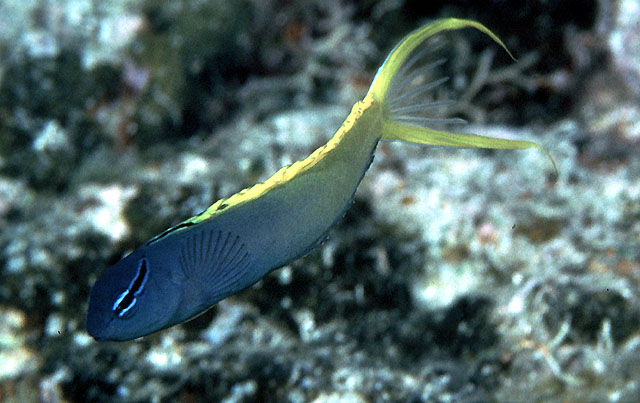| Blenniidae (Combtooth blennies), subfamily: Blenniinae |
| 11 cm TL (male/unsexed) |
|
reef-associated; marine; depth range 0 - 30 m |
| Western Pacific: Bali and the Philippines east to Samoa, north to Ryukyu Islands, south to Rowley Shoals, the southern Great Barrier Reef, and New Caledonia; throughout Micronesia. Replaced by the uniformly yellow species ovalauensis in Fiji, and by Meiacanthus tongaensis in Tonga (Ref. 37816). |
|
Dorsal spines (total): 4-4; Dorsal soft rays (total): 25-28; Anal spines: 2-2; Anal soft rays: 15-18. Identified by the blue-edged diagonal black line from the eye and yellow dorsal fin or back. Adults have long filaments on the caudal fin tips; length without filaments (Ref. 48636). |
| Adults are found solitary or in pairs (Ref. 90102) in lagoon and seaward reefs below the surge zone to 30 m depth (Ref. 9710). A common species, often seen along slopes and drop-offs, adults sometimes in small groups (Ref. 48636). Feed on zooplankton and also on small benthic invertebrates. Inoffensive, but immune from predation (Ref. 9710). Oviparous. Eggs are demersal and adhesive (Ref. 205), and are attached to the substrate via a filamentous, adhesive pad or pedestal (Ref. 94114). Larvae are planktonic, often found in shallow, coastal waters (Ref. 94114). Mimicked by Ecsenius bicolor and Plagiotremus laudanus (Ref. 90102). |
|
Least Concern (LC); Date assessed: 28 March 2009 Ref. (130435)
|
| venomous |
Source and more info: www.fishbase.org. For personal, classroom, and other internal use only. Not for publication.

